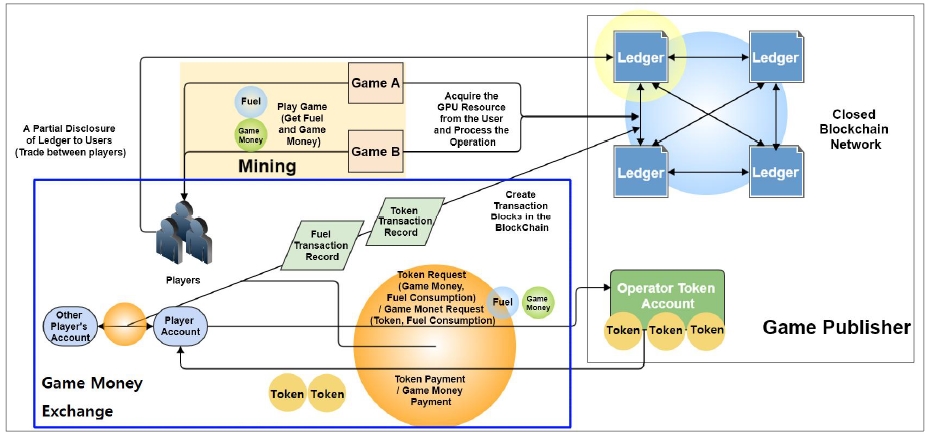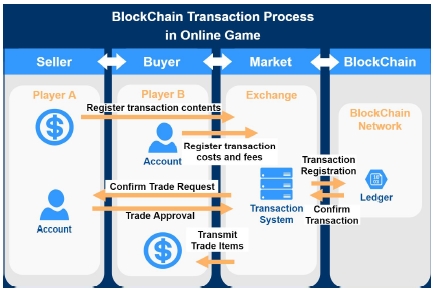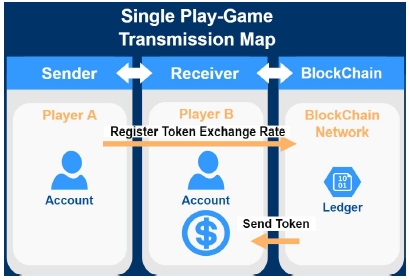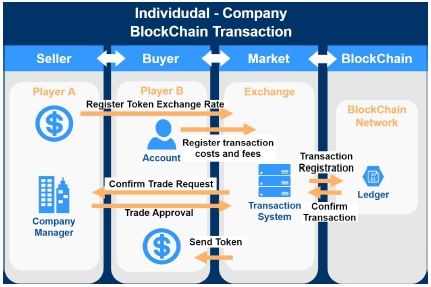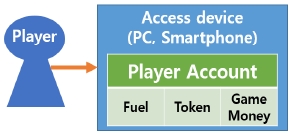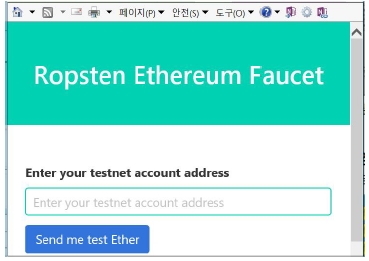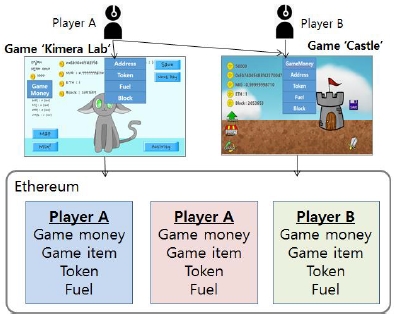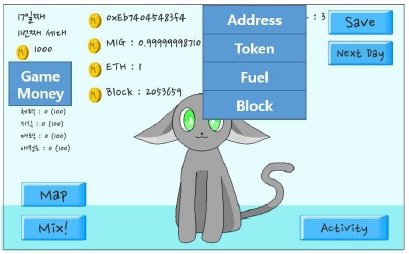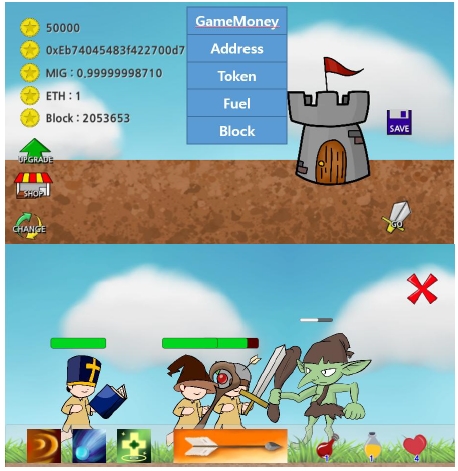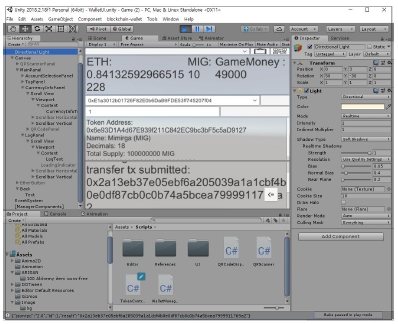
Game Money Exchange System using Blockchain
Copyright ⓒ 2018 The Digital Contents Society
This is an Open Access article distributed under the terms of the Creative Commons Attribution Non-CommercialLicense(http://creativecommons.org/licenses/by-nc/3.0/) which permits unrestricted non-commercial use, distribution, and reproduction in any medium, provided the original work is properly cited.

Abstract
In this paper, an integrated game money exchange system was developed that enables exchange of game money between different game companies or game by using the Ethereum blockchain. Previous game money exchanges depended on third-party intermediary sites, such as 'Item Bay' with paying additional fees. In these process, various fraud cases were reported due to lack of security. Therefore, buyers or sellers were at a disadvantage. It was also difficult for game companies to take proper measures or respond to problems such as user withdrawal because it was difficult to intervene in the flow of game money. As a solution to this problem, this paper proposes a system for transparent exchange of game money between individuals or between individuals and game companies. The proposed system presents a variety of scenarios for online and single-play games, which exchange money between different games into the corresponding Etherium coin as a medium. It also used the Unity Game Engine to produce two different kinds of games and showed that game money exchange is possible between them. The system offers the possibility of creating a transparent and safe exchange ecosystem for game companies and players.
초록
본 논문에서는 이더리움 블록체인를 이용하여 이종 게임사 또는 이종 게임 간의 게임머니 교환이 가능한 통합 게임머니 교환 시스템을 개발하였다. 기존에는 ‘아이템베이’와 같은 제 3의 중개 사이트를 통해 게임머니를 교환함으로써 중개 사이트에 의존적이고 중개사이트에 추가 수수료를 지불해야 하며 교환 과정에서 구조적으로 보안이 허술하여 다양한 사기 사건이 보고되고 있다. 따라서 구매자 또는 판매자가 불이익을 보게 되고 게임사 또한 게임머니의 흐름에 관한 개입이 어려워 사용자 이탈 등 문제점이 발생해도 적절한 조치나 대응을 하기가 어려운 상황이다. 이에 대한 해결 방안으로 본 논문에서는 블록체인 기법을 도입하여 개인과 개인 간, 또는 개인과 게임사 간에 게임 머니를 투명하게 환전하는 시스템을 제안한다. 제안하는 시스템은 온라인 게임과 싱글 플레이 게임을 대상으로 서로 다른 게임 간의 게임머니를 그에 상응하는 이더리움 코인을 매개체로 환전해 주는 다양한 시나리오를 제시한다. 또한 유니티 게임엔진을 이용하여 2개의 서로 다른 종류의 게임을 제작하고 이들 간에 게임머니의 교환이 가능함을 보였다. 이 시스템은 게임사와 플레이어 모두에게 투명하고 안전한 게임머니 환전 생태계 구축의 가능성을 제시하고 있다.
Keywords:
Blockchain, Eutherium, Game money exchange, Game item exchange, Token, Fuel, Game Eco System키워드:
블록체인, 이더리움, 게임머니 교환, 게임 아이템 교환, 토큰, 연료, 게임 에코 시스템Ⅰ. Introduction
Game money is a cash-like currency in a game, Which is paid to buy various game weapons or items. In particular, online games have the internal economy like the real world, so the importance of game money is even higher. As a result, there is a lot of discussion about how to deal with game money within games or how to exchange game money between different games[1].
Currently, single-player games do not support the ability to transfer goods in a game to another single-player game. However, if a player has a previous game of the same game company or game play data, the company rewards users by offering them various exclusive contents when starting a new game. For example, in the game title "Borderland 2," a skin items are provided to users who have a save file from the previous title “Borderland”[2].
Meanwhile, in online games, current users exchange game money through trading intermediaries such as 'Item Bay'[3]. They use trading intermediaries to move their cyber assets to different games from the same game company. After exchanging game money with the real money they have in the ‘A game’, they must move their assets by purchasing game money sold by users of ‘B game’.
The problem with current game money trading system is that game developers, who operate the game are not involved in the game money transaction process. Transaction intermediary sites exist between users and game developers, resulting in a certain amount of fees, which can cause various damages, including costs, for both users and game developers. In addition, game developers lose control in cyberspace called online games, and there are also side effects such as the distribution of game money from illegal personal servers to intermediary sites.[4] Also, according to the terms and conditions of the game and the rules of the law on game products, it is strictly prohibited to cash game money. However, there are many reports of game money fraud, such as receiving money on the condition of exchanging game money. We will introduce blockchain technology as a solution to these various problems.
This paper aims to develop a reliable game money exchange system using blockchain technology. The proposed technology aims to improve the transparency of exchange systems, prevent fraudulent transactions of game money, and reduce central server monopoly and management costs by using block chains with the characteristics of a distributed ledger structures. Blockchain also has the advantage of enhancing security in game transactions because it is very difficult to hack or manipulate transactions that are registered in the transaction ledger.
The composition of this paper is as follows. Chapter 2 examines blockchain systems and research trends related to game money. Chapter 3 describes blockchain based game money exchange systems and concludes in Chapter 4.
Ⅱ. Related Works
2-1 BlockChain
Block chain is a system that records and stores the same transaction in distributed ledger. Each transaction is organized into blocks, and information about when and who made the transaction is recorded. In the blockchain, the 'block' consists of a group of valid transaction information, the block header, the transaction information and other information. Block hash acts as a identifier for each block, and is the value calculated by applying the SHA 256 hash function after the block header information has been entered [5]. Studies using this blockchain are as follows.
A study by Ahn Kyu-hwang [6] shows that safe and transparent transactions are possible by developing bicycle management and donation systems using block chains. Kim's research [7] also developed an online voting system based on the Etherium Block Chain to improve reliability. Research by Seo Eui-sung and Jang Jong-wook [8] examined the safe storage of black box images by using blockchain and clouding. Jay Kishigami's study [9] used blockchain to develop a decentralized digital content distribution system unlike traditional digital rights management systems.
2-2 Commodity trading in games
Recently, the industry has been making various attempts to combine game and Cryptocurrency. A typical example is ‘CryptoKitties’, a block chain game that makes and sells cats to each other[10]. Game developers are working on blockchain tokens such as GxC coin [11] and Yumerium [12]. Research by Kim Jong-soo and Tai Suk Kim suggested auctioning game items for safe online gaming transactions [13]. Kim Yoon-myung and Lee Won Hyung studied the legislative review of game item transactions [14].
Studies of existing product transactions in games pointed out the limitations of the following legacy product transactions. According to Choi's study [15], the existing online game commodity transactions are regulated by game companies because they need control over the cyberspace called games. According to the study, the disadvantages of game companies that lose control in games are thought to be greater than those that game companies maintain control in games. Lee Eun-jo and Woo Ji-young's [16] study searched the amount of real money transactions and network structure of game money that damage the game structure. These studies show that expansion of Real Money Trade(RMT) Market for intermediary sites to be in charge of control have a negative impact on game makers. According to Park Hyun-ah and Lee Jae-jin's study [17], the majority of actual game users expressed concern about the negative effects of item cash transactions on real games, but dissatisfied with terms and conditions of punishment.
Ⅲ. Problems in the Current Game Money Exchange Process
First, we need to understand the current game money exchange process. Figure 1 shows the flow of game money exchange through intermediary sites such as 'Item Bay'. The seller registers the item to be sold and the buyer applies for the transaction. They pay with cash or credit cards after checking each other's counterpart and exchange goods in the game. In this process, various kinds of fraud are reported between actual cash payments and commodity exchanges.
In this paper, the black box part of Figure 1 is replaced by the blockchain-based game money exchange system. This will eliminate the possibility of various types of existing fraud and ensure the integrity and reliability of the system.
Ⅳ. Suggested System Overview
The system is based on an Etherium blockchain network. The concept of the etherium token, fuel, etc. is used in this system for the following purposes. This can be seen in Table 1. A standard token is needed for the exchange of game money in different games, and fuel is used to access the blockchain network when trading tokens.
As shown in Figure 2, the system consists largely of two parts: player mining and game money exchange.
Player Mining : In Etherium, fuel is obtained through spot trading and mining, but in this system fuel and game money are obtained through game play. For game publishers, Players provide computer device resources, such as GPUs, from gaming machines they connected to. The computing devices provided are used by game publishers to operate the network, while players can get fuel and game money through the process of playing the game.
Game Money Exchange : The game money provided is used to ask the token operator of game publishers to exchange tokens. This consumes fuel. The token operator pays the token in the account held by the operator to the player in accordance with the pricing set by the game publisher. Transaction records are written at the ledger as transaction blocks created in the block chain. If the player wants to exchange the token for another game's game money, he or she should send the fuel and token to the operator’s token account. Game companies fuel the internal environment of the game and withdraw fuel from users by collecting negative interest rates and currency exchange fees.
Table 2 shows items (Game Money, Tokens, Fuel) trading between individuals and game companies in the proposed system. Comparisons with existing systems can confirm that the problems which could arise in cash exchange and cash transactions are being solved by the blockchain system.
Ⅴ. Game Money Exchange Scenario
The scenario of exchanging game money in the proposed system depends on who makes a transaction or the type of game. Depending on who the traders are, we classified them as individual transactions and corporate-to-personal transactions. Individual transactions were also categorized as online games and single games, depending on how they were played. Online games are played and by many people. They transact simultaneously in game, so there is a difference in the way when player deals with single player game. The game money exchange scenario changes for each case.
5-1 Individual Transactions
In the case of online games, transactions between users are active because of the nature of the interactive communication between many users. The existing online game trading system allowed users to trade only game items and game money. In this paper, not only game items, game money, but also tokens and fuel are freely traded so that the exchange ecosystem of game money can be created. One example of a typical transaction is token and game money transaction, which we will explain in this paper, as shown in Figure 3.
- (1) The seller registers the number of tokens he wants to sell to the trading system in the game and the amount of game money that corresponds to the value of the token. The system checks to see if the seller has enough fuel and tokens. If it is not enough, the system does not register token trading.
- (2) The buyer requests the purchase with the price he or she wants to purchase and the system checks that he or she has the game money he or she offers, including the fee. A purchase request is registered in the system if the purchaser satisfy the requirements.
- (3) Seller confirms the purchase request and approves the transaction. A token is sent to the buyer using the seller's fuel. In this moment, some of the buyer's transaction fees are paid to the seller and the rest is collected in the game system. This compensates the seller for some of the fuel used on sale and it is an opportunity for game companies to recover part of their coin which they already distributed.
- (4) If a transaction is registered normally in the block chain, the token is sent to the purchaser's account. If transactions are not registered normally in the block chain, the game money presented by the buyer is refunded except for transaction fees already paid. Seller shall re-register the transaction if he or she wishes to resale.
There's very little interaction with other game players in a single player game. Therefore, the focus was on the delivery of goods in the game, not mutual exchange. It can help other players financially.
One of the existing single player games, 'Pokémon Mystery Dungeon : Blue Rescue Team' and 'Pokémon Mystery Dungeon : Explore of Time and Explorer of darkness' allowed players to meet other users in person and communicate wirelessly to be rescued or to ask others for help through their own SOS passwords if player is in a 'Game Over' state. However, in the case of these games, players often failed to get rescue passwords from other users after making SOS requests.
It is because the characteristics of a single player game restricts exchange with other users within the game, which makes users to only get help from outside the game. As a result, player was forced to take a disadvantage in the game process. However, the system presented in this paper makes it very easy for other users to help out when a single player requests help from another user, as shown in Figure 4.
- (1) A seller with a token enters the number of tokens and the addresses to be sent to the trading system. The system checks to see if the seller has enough fuel and tokens. If it is not enough, the system does not register token trading.
- (2) When a transaction is registered in the block chain, the token is sent to the buyer's account and the buyer receives the token. If the seller fails to transact less than a certain number in the process, the system will pay a certain amount of game money in return for the fuel used. However, if they exceed a certain number of times, they no longer pay money to prevent abuse.
5-2 The Process of Transaction in Individual - Company
As shown in Figure 5, for transactions between game companies and individuals, the game company needs to issue tokens and provide them to users. Players can't get a token just by playing a game. Therefore, the token provided by the game company is exchanged for game money.
- (1) The game company notifies users the number of tokens they provide and the amount of game money players need to exchange tokens. Game companies can flexibly adjust the exchange rate of tokens and game money depending on the economic situation in the game.
- (2) The user registers the token trading system by summing the game money and fees corresponding to the number of tokens he or she wants to purchase from the game company.
- (3) The game company checks the user's request and registers token transfer transactions in the block chain.
- (4) If a blockchain transaction is registered normally, the token is sent to the user account by that transaction.
- (5) After confirming that the token transfer was successful, the game company will receive a game money exchange including a fee. If a transaction fails, some of the game money paid is refunded to the user except for the fee.
Ⅵ. System Implementation
In this paper, game money exchange system is developed by utilizing Ethereum blockchain technology. Nethereum Library is used to build Etherium Block Chain[18]. Nethereum is an integrated library of c# that supports access to etherium networks and is compatible with Unity 3D gaming engines.
6-1. Building an Ethereum Network
Account Composition : The game player's account consists of information (exchangeable tokens which player has, fuel for accessing the blockchain network, and game money) as shown in Figure 6. Player can access the account using the access method that he or she has.
Create Wallet : The tool Metamask[19] was used to create a 'Wallet' to implement a game player's account. From the wallet screen, player can send he or she's token to the address he or she entered, request a token from the game publisher's operator, or request game money. This creates a transaction. The wallet screen also shows the name of the player's account, the amount of fuel, the number of tokens, game money he or she has, and the log of the transfer as shown in figure 7.
Token Transmission : 'Ropsten Testnet Transaction'[20] was used to implement token transmission. When a player requests a token exchange, the game company exchanges the token with the game money and allows player to send the token to other users. Figure 7 shows the senders, recipients, token quantities, and gas fees in ETH as a token transfer screen that sends the token to the Etherium account address.
Fuel Acquisition : Fuel used as a fee was obtained from the external site 'Ropsten Ethereum Faucet'[21]. Player can obtain fuel by entering the account number as shown in Figure 8.
In the proposed system, game operators purchase ether and distribute it to users through game play in the form of gas. Each transaction must pay the gas cost to the Ethereum, which is calculated as shown in formula (1).
| (1) |
Gas price is the value of gas that the player suggests when trading. The unit is gwei. 1 gwei corresponds to 0.000000001 ether. The higher the suggested gas price, the faster the transaction will be. Gas limit is the limit of gas to be used for the block chain transaction. According to the Ethergas Station site, the average gas price used for transactions as of December 21 is 2.5 gwei and the average gas limit is 21,000 [22]. This can be seen in Figure 9.
Calculating the formula (1) yields 2.5 * 21,000 = 52,500 gwei, which is 0.0000525 ether. Based on Ether's market value, the transaction fee is approximately 0.005 to 0.006 dollars, which means that the operator pays approximately $5 to $6 per 1000 transactions between users. It can be said that the cost of maintaining and managing the system is not very high.
Transaction : Transactions created for the trade indicate whether the transaction was successful/failed, who sent, who received, the value sent, and the cost of the transfer. A unique value called txhash is generated for each transaction, which allows player to verify that the transaction is abnormal or falsified.
In this system, the token exchange process was implemented as follows:
6-2. Game Development
Two different types of games were implemented and 2 game money exchanges were attempted over the Ethereum network. Through token exchange on the Ethereum network, we experimented with the exchange of game money between two different kinds of games as in Figure 10. Game money in each game is obtained through game play.
The first game implemented in this paper is 'Kimera Lab', a pet raising game, and the second game is 'The Castle', a Castle Building simulation game, which are both single-player games. 'Kimera Lab' is a game which player raise his or her virtual pet's ability and take care of their appearance as player want. 'The Castle' is a game aimed at clearing the stage where monsters come out and earning game money to upgrade castle structures in the game.
Figure 11 shows the game 'Kimera Lab'. In this game, player can raise his or her pet's ability (strength, knowledge, charm and affection) as the game progresses. Player can earn game money through various tasks (beg, WorkPartner, Port, Acrobatics, Ad) by using his or her pet's ability. At this time, the amount of game money that can be acquired depends on the type of work. For example, a Beg activity can achieve random game money in the range of 1 to 100 and an Acrobat activity can earn in the range of 250 to 300. The consumption of game money occurs when player tries to dramatically increase his or her pet character's ability. Table 3 summarizes the 'Kimera Lab' game's Abilities, Tasks, and game money.
Figure 12 shows the game 'The Castle'. In this game, player can earn game money by defeating monsters and clearing the stage. Player uses game money to purchase game items (Potion, etc.) to help stage clear and upgrade the characters inside the game (warrior, wizard, healer), their skills, and Castle structures inside the game. Whenever a stage with monster is cleared, game money can be randomly obtained in the range of 200 to 1000. The game money which player acquired is consumed through purchasing items, upgrade character level, skill, and castle. Table 4 summarizes ‘The Castle’ game's Abilities, Skills, Works and game Item.
Each transaction for game money exchange was implemented in the form of adding a fee to the transaction after setting the ratio of 'Kimera Lab' game money to 'The Castle' game money by 1:1. When applied to real games, it will be necessary to change the amount of fees and game money exchange rates depending on the value of game money. In example, games which is relatively hard to earn game money should be allowed to exchange lower fees and lower amounts for tokens.
Figure 13 shows a token transaction inside the 'The Castle' game. The txHash address at the bottom of the screen shows that the token was transferred. The top of the screen shows the amount of ether (ETH), token (MIG), and GameMoney (GameMoney) that users have.
Ⅶ. Experiment and Evaluation
The system implementation was conducted on a core i7 SkylakeX 7820X desktop PC with one NVIDIA Titan XP and 128GB of memory. To verify the blockchain transaction system developed in this paper, we will compare and evaluate the existing system using a third-party intermediary site.
The performance of comparing the existing game item intermediary site and block chain trading system proposed in this paper is evaluated as shown in Table 5. The intermediary site currently in use is purchased through a third 'intermediary site' between the parties involved in the transaction. In this process, there is no part where game companies can intervene and players should pay a fee to an intermediary site. However, in the proposed system, the parties can trade with each other within the game, and the fees can be shared between the game company and the trader.
On the current sites, consumers cannot confirm whether a trader is trading goods that he or she obtained from violation of regulations in a game, such as botting. This system allows consumers to easily detect a seller like this because it allows them to check the buyer's trade history. This is because, due to the nature of the block chain, all transactions are written on the block and are not erased. Therefore, it can have higher credibility than current websites.
We will also compare the performance of GXC, which is attempting to exchange game goods based on blockchain.[Table 6] The proposed system is based on etherium - based platform because it aims at safer exchange of game money rather than real time. The performance of the Ethereum is about 20 TPS (50-100 TPS expandable), which is slow but has a strong safety advantage. In the etherium POW(Proof of Work) method, it is difficult to actually manipulate the transaction unless a hacker can obtain a 51% stake. On the other hand, the GXC is building a fast EOS-based platform to exchange game goods in real time and the GXC coin's processing performance index has been announced at 5,000 TPS. The GXC coin is a DPOS(Delegated Proof of Stake) method where only 21 block producers can create blocks. DPOS method is vulnerable to hacking because hackers only need to attack a small number of block producers for network disturbances. In this way, if coin holders are indifferent to the ballot, problems such as the abuse of authority of their representatives may arise. Table 6 summarizes the proposed method compared to GXC.
Ⅷ. Conclusion and Discussion
In this paper, two different types of games were developed and showed that token trading between them was possible by applying the Unity game engine and the Ethereum Block Chain. We suggested a scenario of individual versus individual game money exchange in online games, and game money exchange between individuals and game companies, as well as a scenario of individual to individual game money exchange in single player games. And using the Unity game engine, we developed each pet raising game and simulating castle game which confirmed that tokens are traded safely and transparently between two different types of games.
The proposed system can significantly reduce damages such as hacking or misuse by deploying a integrated exchange system for game money using blockchain. Game players can ease the inconvenience caused by game money exchange through a third-party intermediary site and no longer suffer disadvantages due to fraud in the process.
Also, game companies will be able to exchange tokens with game money as previously announced. This will help them to participate more effectively in economic coordination within the game. If a game system like this is developed within the same game company, it is expected that users will move more actively within same company's game instead of losing their users to third-party games. It will also allow smooth movement of goods between games. A more transparent game ecosystem can be built by applying the system proposed in this paper between different game companies(NEXON & NCSoft), or between different game platforms(PS Game & Xbox Game), currently operating somewhat closed.
However, it is still difficult to completely replace the demand in the current spot market. If player thinks that the gains from the in-kind trading of goods in the game outweigh the ones through the token, he or she can try the in-kind. Also, since the economy within a game is different for each game system, it can be a little difficult to apply the same system to all games.
Future studies will need to study token transmission systems based on their own platforms, not on Ethereum. It should also make efforts to build a transparent and safe gaming ecosystem by laying the foundation for the system proposed in this paper.
Acknowledgments
This work was supported by the Sungshin Women’s University Research Grant of 2018.
References
- S. R. Choi, “A Study on the Regulation of Real Money Trade in On-line Game”, Journal of Korea Game Society, 7(2), p41-52, June), (2007.
- https://www.polygon.com/gaming/2012/7/6/3141933/only-veteran-borderlands-players-can-unlock-these-borderlands-2-skins
- http://lecture.cfe.org/info/bbsDetail.php?cid=13113&idx=42943
- http://www.thisisgame.com/webzine/news/nboard/4/?page=692&n=6474
- K. H. An, H. J. Seo, "Building bicycle management system using Blockchain", Journal of the Journal of the Korea Institute of Information and Communication Engineering, 22(8), p1139-1145, (7 pages), Aug), (2018.
- K. H. An, H. J. Seo, “Donate system development using Blockchain technology”, Journal of the Korea Institute of Information and Communication Engineering, 22(5), p812-817, (6 pages), May), (2018.
- C. J. Kim, “An Online Voting System based on Ethereum Block-Chain for Enhancing Reliability”, Journal of the Korea Academia-Industrial cooperation Society, 19(4), p563-570, Apr), (2018.
- E. S. Seo, J.W. Jang, "Design of Driving Record System using Block Chain", Journal of the Korea Institute of Information and Communication Engineering, 22(6), p916-921, Jun.), (2018.
-
Jay Kishigami, “The Blockchain-Based Digital Content Distribution System”, IEEE Fifth International Conference on Big Data and Cloud Computing (BDCloud), p187-190, (2015).
[https://doi.org/10.1109/bdcloud.2015.60]

- https://www.cryptokitties.co/
- http://gametoc.hankyung.com/news/articleView.html?idxno=49852
- http://www.datanet.co.kr/news/articleView.html?idxno=127158
- J. S. Kim, T. S. Kim, “A Design Method of Auction type e-Commerce for Online Game Items Exchange”, Journal of Korea Multimedia Society, 13(1), p153-160, Jan), (2010.
-
Y. M. Kim, W. H. Lee, “Legislative Review of the Game Item Trading”, Korean Society For Computer Game, 29(2), p117-124, June, 30), (2016.
[https://doi.org/10.21493/kscg.2016.29.2.117]

- S.R. Choi, "An Analysis of Interest Relationship among IStakeholders in Online Game Item Trading : A Study on the Relationship Between Interests in cyberspace", Korean Republic Admistration Review, 40(2), p219-241, June), (2006.
- E. J. Lee, J. Y. Woo, "No Silk Road for Online Gamers!: Using Social Network Analysis to Unveil Black Markets in Online Games", WWW '18 Proceedings of the 2018 World Wide Web Conference, p1825-1834, April 23 - 27, 2018.
- H. Y. Park, J. J. Lee, "On-line MMORPG Users’ Understanding about the Agreements of Cash Transaction Prohibition", Journal of Media Law, Ethics and Policy Research, 15(1), p143-181, (2016).
- https://github.com/Nethereum/Nethereum
- https://metamask.io/
- https://ropsten.etherscan.io/
- https://faucet.ropsten.be/
- https://ethgasstation.info/index.php
저자소개

2017 : Department of Convergence Security Engineering at Sungshin Women's University (Bachelor of Science)
2014~2017: Sungshin Women's University (Department of Convergence Security Engineering)
2017~Now: Researcher in the Computer Graphics Lab of Sungshin Women's University
※Interests: Computer Graphics, Game, Personal Information etc.

1990 : Department of Computer Science at Yonsei University (Bachelor)
1992 : KAIST Department of Computer Science (Master)
2004 : KAIST Department of Computer Science (Ph.D)
1992~1996: KBS Broadcasting Technical Research Institute
2006~Now: Professor in Department of Information System Engineering of Sungshin Women’s University.
※Interests: Computer Graphics, Game, Big Data Visualization etc.


